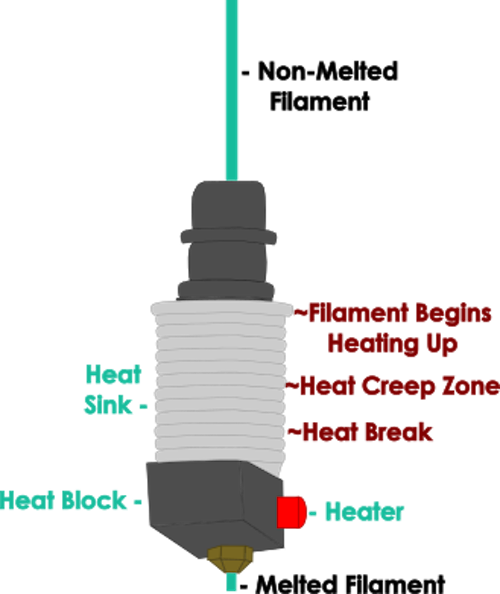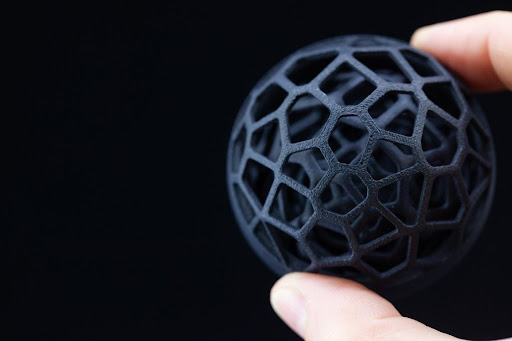Time to read: 7 min
3D printing has revolutionized the way we bring ideas to life by offering unprecedented freedom of design and manufacturing possibilities. But with every great invention comes new challenges, and every 3D printing enthusiast has encountered the phenomenon known as “heat creep.” Heat creep can severely influence the quality of your prints, leading to filament jams, clogs, and unreliable extrusion. Fortunately, understanding the causes and implementing effective preventive measures can optimize 3D printer performance and produce flawless prints.
In this article, we’ll explore the concept of heat creep in 3D printing and delve into practical strategies to prevent it. Whether you’re a seasoned 3D printing enthusiast or a beginner eager to enhance your printing skills, the insights and techniques shared here will help you prevent and fix heat creep in your 3D printer.
What Is Heat Creep in 3D Printing?
Heat creep occurs in hot extrusion 3D printers, including FFF (Fused Filament Fabrication) and FDM (Fused Deposition Model) 3D printers. It refers to the unintentional transfer of heat from the hot end, where the filament melts, to the cold end where filament is fed into the printer’s extruder assembly.

As shown in the diagram above, heating should only happen in the heat sink zone and below. When heat transfer occurs above the heat sink, you get premature heating of the filament, and problems like filament softening and clogging that lead to printing issues. There are a few reasons why heat creep might occur, and most of them can be controlled or mitigated.
So, how do you know if your 3D printed part has heat creep? Here are some common symptoms:
- Warping: The filament exhibits poor adhesion to the print bed, which warps and deforms the printed object.
- Clogging: The melted filament can block the nozzle, which jams the extruder and prevents proper flow.
- Strings or Threads: During non-printing moves, the molten filament inadvertently escapes from the nozzle and leaves undesirable strings of material on the print.
- Over-Extrusion: The extruder dispenses an excessive amount of filament and forms blobs or irregular layers in the printed object.
- Uneven Heating: The hot end of the printer doesn’t distribute heat evenly, which causes inconsistent extrusion and weak bonding between layers.
What Causes Heat Creep in 3D Printing?
There are a few factors that can lead to heat creep in a 3D printer, including:
- Poor thermal insulation
- Overheating of the hot end
- High ambient temperatures
- Poor material choices for critical components
- Poor cooling of critical components
Let’s explore how each of these situations can cause heat creep:
Poor Thermal Insulation
Inadequate or insufficient thermal insulation around the hot end of the printer can lead to heat escaping from the intended area and affecting other components. This results in heat creep as the heat moves toward the cold end. Poor thermal insulation makes the printer inefficient as well, since not all of the energy put towards melting the filament is used for the right purpose.
Overheating of the Hot End
If the hot end of the printer operates at excessively high temperatures, it can accelerate heat transfer to the cold end. This happens due to incorrect temperature settings, faulty temperature sensors, or insufficient cooling mechanisms.
High Ambient Temperatures
When the overall environment surrounding the printer is too hot, it can impact the printer’s ability to dissipate heat effectively. This causes excess heat to build up within the extruder assembly and leads to heat creep.
Poor Material Choices for Critical Components
The choice of materials for key components of the extruder assembly, such as the heat break or heat sink, can contribute to heat creep. If the materials used are not suitable for conducting heat away efficiently or if they have poor thermal properties, it could lead to heat creep. For a review of what materials have the best thermal conductivity, check out our Heat Exchanger Material Selection guide.
Poor Cooling of Critical Components
Efficient cooling of the hot end is crucial to prevent heat creep. If the cooling mechanisms, such as fans or heat sinks, are not functioning properly or if their airflow is restricted, the heat dissipation is compromised.
To mitigate heat creep and promote consistent and reliable 3D printing results, it’s critical to monitor and address these causes. This can involve improving thermal insulation, ensuring appropriate temperature settings, maintaining suitable ambient temperatures, selecting suitable materials for critical components, and optimizing cooling mechanisms.
How Do You Insulate a 3D Printer Hot End?

Heat creep can be mitigated through hot-end insulation. Insulation acts as a barrier, preventing heat from escaping from the hot end and affecting other components of the printer, such as the heat sink or cold end. It helps to maintain a localized and controlled environment around the hot end, which is crucial for proper filament melting and extrusion.
There are several methods you can use to insulate a 3D printer hot end. Here are a few common methods:
- Insulating Sleeves or Socks: One popular method is to use insulating sleeves or socks designed specifically for 3D printer hot ends. These sleeves are typically made of heat-resistant materials like silicone and are designed to fit snugly around the hot end. They provide a layer of insulation that helps retain heat and maintain stable temperatures.
- Insulation Tape: Another method is to use high-temperature insulation tapes, such as ceramic fiber or Kapton® tape. You can wrap the tape around the hot end to create a layer of insulation — just be sure to use tape rated for high temperatures so it doesn’t melt or degrade.
- Thermal Paste or Putty: Thermal paste or putty with high thermal conductivity can be applied between the hot end and the heating block to enhance heat transfer while also acting as an insulator. This method helps to keep the heat concentrated around the nozzle area.
- Insulating Enclosures or Shrouds: Some 3D printers come with or have the option to add an insulating enclosure or shroud around the entire hot-end assembly. These enclosures help trap heat within the printing area, providing insulation to the hot end and minimizing heat loss.
- Ceramic Fiber Blanket: For more advanced insulation, you can use a ceramic fiber blanket around the hot end. This material is highly insulating and can withstand high temperatures. It can be wrapped or secured around the hot-end assembly to provide effective insulation.
Remember, it’s important to ensure that your insulation materials can withstand the high temperatures generated by the hot end to prevent any safety hazards or damage to the printer. Always refer to the manufacturer’s guidelines or consult the printer’s documentation for specific recommendations on insulating the hot end.
How Can You Prevent Heat Creep?
To avoid heat creep, you can take several measures, including:
- Proper Cooling: Ensure that the hot end of your 3D printer has adequate cooling. This usually involves a cooling fan or fans directed toward the heat sink and the heat break region. The cooling fan helps dissipate heat and prevent it from traveling up the filament.
- Fan Speed Adjustment: Check the fan speed settings on your 3D printer. It’s important to have the cooling fan running at an appropriate speed during the entire printing process, especially when the hot end is at higher temperatures. Adjust the fan speed based on the filament material you are using and the recommended cooling guidelines for that particular filament.
- Heat Sink Quality and Installation: Ensure that the heat sink attached to the hot end is of good quality and properly installed. The heat sink should have sufficient surface area and efficient fins to dissipate heat effectively. Additionally, ensure there is proper thermal contact between the heat sink and the heat break — which is usually achieved through the use of thermal paste.
- Insulation: Use thermal insulation around the heat block and heat sink to minimize heat transfer to other components. Insulation can help maintain a stable temperature in the hot end and reduce the chances of heat creep.
- Retraction Settings: Proper retraction settings can also play a role in preventing heat creep. Retraction refers to the process of pulling the filament back slightly during non-printing moves to prevent oozing or stringing. Adjusting the retraction distance and speed can help reduce the chances of filament softening and heat creep.
- Filament Quality and Diameter: Ensure you are using high-quality filament that is within the specified diameter range for your 3D printer. Filaments with an inconsistent diameter or poor quality may increase the chances of heat creep due to uneven melting and flow characteristics.
- Printing Speed: Increasing the print speed is essential to prevent heat from traveling up the extruder and prematurely melting the plastic filament. By ensuring that the filament spends minimal time in the heated region before reaching the nozzle, you can prevent softening and blockages.

Key Takeaways for Preventing Heat Creep When 3D Printing
- Heat creep is the unintentional and undesirable transfer of heat from the hot end of a 3D printer extruder (nozzle/heater interface) to the cold end of the extruder. It results in filament clogs, jams, insufficient adhesion between filament layers, and improper extrusion.
- Heat creep often shows up as physical defects in your 3D printed part: clogging, strings, threads, over-extrusion, warpage, or uneven heating.
- Common causes of heat creep include: improper thermal insulation, hot end overheating, excess ambient temperature around the 3D printer, or poor cooling of critical components.
- Prevent heat creep by improving the thermal insulation around the heat sink, maintaining environment temperature, making sure not to overheat the filament, utilizing correct materials for parts that require good heat transfer, and optimizing cooling mechanisms.
High-Quality 3D Printed Parts With Fictiv
Heat creep is a common issue in 3D printing, but it’s possible to prevent. By understanding the causes of 3D printing heat creep and implementing effective prevention measures, 3D printing enthusiasts can enjoy optimal printer performance and produce high-quality prints.
Or, you can work with the 3D printing experts at Fictiv. Our manufacturing partners are well versed in the measures required to prevent heat creep and deliver high quality printed parts in a variety of materials.
To get started, create your free Fictiv account and request a 3D printing quote today — we make complex 3D printed parts in as little as 24 hours!










